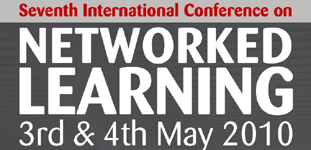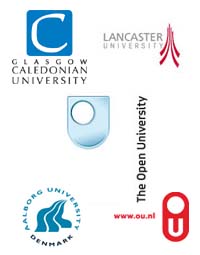

Web 2.0 and Problem Based Learning in Enterprise Architecture Training – Developing a Learning Methodology
Symposium Organisers: Thomas Ryberg
Aalborg University, Aalborg, Denmark
Introduction
This symposium is brought together by research and development carried out in relation to the EU-funded research project “Innovative Enterprise Architecture Education and Training Based on Web 2.0 Technologies” (EATrain2). The overarching aims of EATrain2 project are:
“[...] to identify the training and educational needs of employees in both public and private sector and university students regarding EA and to fulfil these using innovative pedagogies and practices based on Web 2.0 technologies and active, problem-based learning approaches.”
The EATrain2 project consortium comprises partners from six European countries and stakeholders from both business, the public sector and academia: University of Macedonia (Project Leaders - Greece), Euroconsultants SA (Greece), University of Koblenz-Landau (Germany) , Aalborg University (Denmark) , BOC Asset Management GmbH (Austria), "Cities on Internet" Association (Poland), National University of Ireland (Ireland).
The EATrain2 project is composed of four main work packages (WPs) which run consecutively from January 2009 to December 2010 with half a year allocated for each work package. The task of WP1 was to identify stakeholders’ needs regarding Enterprise Architecture Training, and this work package was concluded in summer 2009. The outcomes were a formal ontology and a textual description identifying the relevant skills, knowledge and attitudes of an Enterprise Architect to be attained in courses within the university, public and private sector. The objective of WP 2 is to further the work from WP1 by developing a Problem Based Learning methodology, which capitalises on web 2.0 technologies. This will provide the background for work of WP3, which consists in the development of course models and a platform for carrying out three pilot courses. Finally, the objective of WP4 is to evaluate the three pilot courses designed for business, the public sector and academia respectively.
This symposium addresses work and research carried out in relation to Work Package 2, which is headed by researchers from Aalborg University (Denmark). The main objectives for this work package are:
- To examine the use of active, problem-based learning approaches in the training and teaching of EA.
- To identify means in order to electronically support training and learning of the skills, knowledge and abilities that emerged from WP1.
- To identify how Web 2.0 related technologies could enhance the training and learning of skills, knowledge and abilities that have emerged from WP1
- To consolidate the derived knowledge from this WP with the development of an training and learning methodology which will capitalize on the EA learning ontology to identify and address learning needs
In this symposium we report the research and work carried in relation to these objectives. In particular, we focus on the development of a learning methodology, which capitalises on PBL and web 2.0 technologies. The three papers in this symposium each address important aspects and corner-stones of this work, by discussing theoretical and methodological questions associated with the development of such a learning methodology and outline the contours of the final outcomes of the work package.
In the first paper Glud et al, (2010) review, synthesise and discuss notions such as web 2.0 and learning 2.0, which have been prominent concepts within Networked Learning and educational research within the last few years. Glud et al. (2010) outline the potentials that are being associated with web 2.0 technologies and practices, but also critically discuss gaps between hypothesised or assumed potentials and then the actual experiences and evidence available in relation to educational uptake of web 2.0 technologies and practices. This is done by highlighting a number of tensions which emerge from educational use of web 2.0, but which Glud et al. (2010) argue can be used as resources for design and as an input for the overall learning methodology discussed in Buus et al. (2010). This is accomplished by identifying four central aspects (learning process, motivation, infrastructure and resources/content), which the authors argue can be more or less controlled by either teachers or learners (or distributed between them). From these the authors distils a number questions which can be used by practitioners to critically reflect on their values and priorities in relation to actual design of networked learning courses, capitalising on web 2.0 oriented learning. Finally, the authors discuss how this work has and will be furthered through development of mediating design artefacts and use of the wiki-based community ‘Methopedia’, which has been developed as part of the EU project COMBLE.
In the second paper Ryberg et al. (2010) highlight the connections between Problem Based Learning and web 2.0 technologies and practices. The authors draw on the insights of the preceding papers, but also argue how our currents understandings and PBL-practices might be challenged and expanded. This is accomplished by discussing various interpretations and understandings of terms such as ‘social’ and ‘collaborative’ within theories such as networked learning and connectivism – some of which have arisen with the emergence of web 2.0. The authors argue that the more complex discussions and subtle differences between various theories and pedagogies can in turn be translated into more concrete models or concepts that are relevant for practitioners in designing for networked learning. This feeds into and contributes to the overall learning methodology which is the focus of the third and final paper of the symposium.
In the final paper Buus et al. (2010) discuss the notion of a learning methodology, and situate this within the wider frame of learning design or “Designing for Learning”. They discuss existing work within this broad area and different approaches and interpretations of learning design. As a part of developing the learning methodology the authors introduce a particular method for learning design: Collaborative E-learning Design method (CoED) and how this method has been developed. Furthermore, the authors outline how the learning methodology will be applied in the EATrain project as a way of enabling teachers and practitioners to design courses capitalizing on a problem based learning approach and web 2.0 practices, which builds heavily on the questions, models and concepts introduced in Glud et al. (2010) & Ryberg et al. (2010). As part of the collaborative e-learning design (CoED) method and the broader learning methodology the authors held a workshop for the project partners, and the results and input from this workshop will be briefly discussed in the paper.
Contributing to a Learning Methodology for Web 2.0 Learning – Identifying Central Tensions in Educational Use of web 2.0 Technologies
Louise Nørgaard Glud, Lillian Buus, Thomas Ryberg, Marianne Georgsen,
Jacob Davidsen
Department of Communication and Psychology, e-Learning Lab – Centre for User Driven Innovation, Learning and Design, Aalborg University
Abstract
This paper contributes to the development of a methodology for designing Web 2.0 mediated learning based on a PBL approach. It does so by identifying tensions in the cross field between learning and Web 2.0. To establish an overview we begin by defining the intersections between learning and Web 2.0. In relation to this, and with reference to (Ryberg, Glud, Buus, & Georgsen, 2010), we argue that a problem-based approach to learning fits well with the characteristics of Web 2.0 activities. Moreover, we argue that the connection between Web 2.0 and learning gives rise to an overarching tension between who controls the networked learning environment and processes: the teacher or the learner? We propose a conceptual model where this tension can be understood as expressible across at least four dimensions: the learning process, the motivation, the infrastructure, and resources/content. Also we identify a number of crucial questions that need to be considered in relation to each of these dimensions when designing for web 2.0 mediated learning. These questions and tensions are what we explore in this paper as they contribute to the development of a learning methodology and some mediating design artefacts, which we further discuss in (Buus, Georgsen, Ryberg, Glud, & Davidsen, 2010). The intention of the conceptual model and questions is to prompt practitioners to discuss and critically reflect on their course designs during the planning and design phase. Furthermore, we discuss some additional mediating design artefacts, which we are developing to support practitioners’ design of Web 2.0 oriented learning. These are descriptions of existing practices and activities which will be uploaded in the wiki-based social community Methopedia.
Identifying Differences in Understandings of PBL, Theory and Interactional Interdependencies
Thomas Ryberg, Louise Nørgaard Glud, Lillian Buus, Marianne Georgsen
Department of Communication and Psychology, e-Learning Lab – Centre for User Driven Innovation, Learning and Design, Aalborg University
Abstract
In this paper we discuss networked Problem Based Learning (PBL) and relate this to ideas on web 2.0 learning. Some of the core concepts associated with web 2.0 technologies and practices, such as collaboration, active participation, creation and sharing are well aligned with common interpretations of PBL as a more student-centred pedagogy focusing on students’ active (collaborative) production of knowledge through engaging with problems. While there are some obvious connections between PBL and web 2.0 technologies, many of the thoughts and ideas that have arisen in relation to web 2.0, such as Personal Learning Environments (PLEs), also challenge notions of PBL, but equally hold opportunities to expand our understandings of this pedagogical approach. Likewise, we discuss how certain interpretations of networked learning (Jones & Dirckinck-Holmfeld, 2009; Jones, Ferreday, & Hodgson, 2008) and ideas articulated around the notion of connectivism (Siemens, 2005) might challenge and expand our understandings of PBL. While these discussions are more theoretically oriented our aims in this symposium are to translate these more complex discussions and subtle differences between various theories and pedagogies into more concrete models or concepts that are relevant for practitioners in designing for networked learning. However, the more intimate relations between models and concepts and practical design, will be discussed in Buus et al. (2010).
Developing a Design Methodology for Web 2.0 Mediated Learning
Lillian Buus, Marianne Georgsen, Thomas Ryberg, Louise Nørgaard Glud,
Jacob Davidsen
Department of Communication and Psychology, e-Learning Lab – Centre for User Driven Innovation, Learning and Design, Aalborg University
Abstract
In this paper we discuss the notion of a learning methodology and situate this within the wider frame of learning design or “Designing for Learning”. We discuss existing work within this broad area by trying to categorize different approaches and interpretations and we present our development of particular ‘mediating design artefacts’. We discuss what can be viewed as a lack of attention paid to integrating the preferred teaching styles and learning philosophies of practitioners into design tools, and present a particular method for learning design; the COllaborative E-learning Design method (CoEd). We describe how this method has been adopted as part of a learning methodology building on concepts and models presented in the other symposium papers, in particular those of active, problem based learning and web 2.0-technologies. The challenge of designing on the basis of an explicit learning philosophy, and still trying to develop a design method or tool with a certain general applicability is discussed at the end of the paper. Experiences from a recent design workshop are described and discussed, with a focus on what specific steps have been taken in order to apply the method successfully within the EAtrain2 project as a way of enabling teachers and practitioners to collaboratively design courses. As part of the collaborative e-learning design (CoED) method and the broader learning methodology the authors held a workshop for the project partners in the EATrain2 project, and the results and inputs from this workshop will be briefly discussed in this paper and in the symposium presentation.
| About NLC | Welcome Messages| Acknowledgwments | Conference Proceedings| Keynote Speakers| Index of Presenting Authors| Contact |